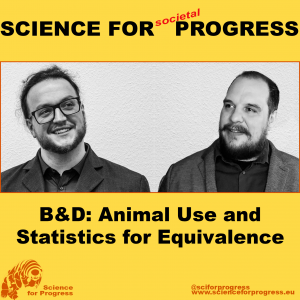Podcast: Play in new window | Download (Duration: 32:50 — 15.0MB)
Subscribe: Google Podcasts | RSS | More

In the light of the latest animal use numbers in Germany (2017), Bart and I are having a conversation about animal use in fundamental research. We then move on to talk about a new statistical method that might help researchers get some of their data out of their drawers and into an article!
Animal Use in Germany 2017
Numbers in short (as presented by tagesschau.de):
- Total: > 2 Million
- 1.37 Million Mice
- 255.000 rats
- 240.000 fish
- 3300 dogs
- 718 cats
- 3472 monkeys
- 50% for fundamental research
- 27% drug production and testing
- 15% for disease research
- 740.000 animals were killed for organ examination
Bart and I regularly discuss the merit of animal research on social media, and we also had a podcast episode on animal wellfare in science.
Our conversation mostly is about fundamental scientific research – which is what we do. We talk about how scientists don’t prefer animal experiments, if there are better ways to answer the research question. But we also mention how difficult it is to know in advance what the outcomes of a study will be good for, particularly in fundamental research. We then address the ethical considerations of the value we assign to different animals.
Testing your data for equivalence
The statistical tests usually applied in scientific studies look at the data of two or more groups and check whether they are different enough to say that there is an effect between them.
It appears that often lack of such differences is used as an argument against publishing the data at all. Because of this, experiments may be repeated unnecessarily by different groups, simply because they don’t know about the results.
The paper that Bart highlights is “A new statistical method to test equivalence: an application in male and female eastern bluebird song” by Rose et al, 2018 (link below). In order to show that the songs of male and female Eastern Bluebirds are not just not significantly different, but identical, they applied this new statistical method.
This may allow scientists to pick up some of their old studies and publish them!
Do you have questions, comments or suggestion? Email info@scienceforprogress.eu, write us on facebook or twitter, or leave us a video message on Skype for dennis.eckmeier.

sources:
• Figures of animals used for scientific purposes in Germany
• FORSCHUNG MIT TIEREN IMMER EFFIZIENTER (“research on animals is becoming more efficient”)
• PRESSEKONFERENZ DER INITIATIVE TIERVERSUCHE VERSTEHEN (press conference of the initiative “understanding animal experiments”
• Verwendung von Versuchstieren im Jahr 2017 (Use of laboratory animals in 2017 – official website of the German Federal Ministry for Agriculture and Nutrition)
new statistical method:
• A new statistical method to test equivalence: an application in male and female eastern bluebird song